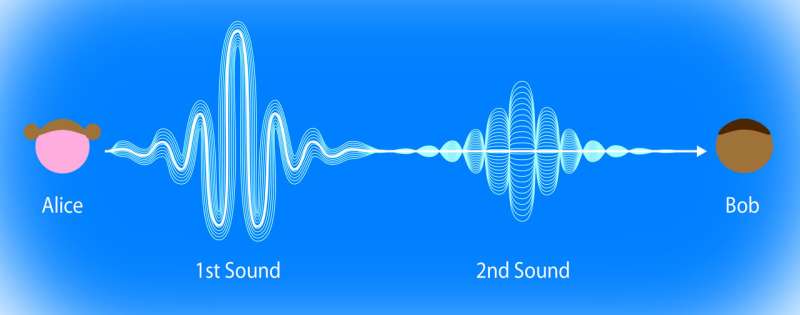A new path to understanding second sound in Bose-Einstein condensates

There are two sound velocities in a Bose-Einstein condensate. In addition to the normal sound propagation there is second sound, which is a quantum phenomenon. Scientists in Ludwig Mathey's group from the University of Hamburg have put forth a new theory for this phenomenon.
When you jump into a lake and hold your head under water, everything sounds different. Apart from the different physiological response of our ears in air and water, this derives from the different sound propagation in water compared to air. Sound travels faster in water, checking in at 1493 m/s, on a comfortable summer day of 25°C. Other liquids have their own sound velocity, like alcohol with 1144 m/s, and helium, if you go to a chilling -269°C for its liquefied state, with 180 m/s.
These liquids are referred to as classical liquids, examples for one of the primary states of matter. But if we cool down that helium a few degrees more, something dramatic happens, it turns into a quantum liquid. This macroscopic display of quantum mechanics is a superfluid, a liquid that flows without friction.
So what do you hear if you make the unfortunate decision to stick your head into this liquid? Surprisingly, you will hear the same sound twice. In addition to the normal sound of a liquid there is the phenomenon of second sound that derives from the quantum nature of this liquid. If someone says something to you while immersed in superfluid helium, you will hear it as first sound first, and then get a second chance to listen when it arrives as second sound, albeit strongly muted. For superfluid helium, second sound is quite a bit slower than first sound, with 25 m/s vs. 250 m/s, between 1 and 2 Kelvin.
While the conventional theory of second sound has been successful for superfluid helium, the rise of Bose-Einstein condensates of ultracold atoms has posed new challenges. A team of scientists led by Ludwig Mathey from the University of Hamburg have put forth a new theory that captures second sound in these quantum liquids, recently published in Physical Review A.
"For superfluid helium, second sound is slower than first sound," explains co-author Vijay Singh, "but we were amazed to find that this is not necessarily true, that the second pulse can be faster." A new theoretical approach was needed to capture this. Modern problems require modern solutions, as they say.
"We generalized the Feynman path integral to expand the theory of superfluids," describes lead author Ilias Seifie the conceptual advance. While the path integral, brilliantly conceived by Richard Feynman, formulates quantum mechanics as a sum over trajectories, these trajectories themselves are classical. "We modified what these trajectories look like' continues Seifie, "in our path integral they contain information about quantum fluctuations." Imagine a pool noodle that stretches from A to B as a poor man's visualization of a trajectory that enters the Feynman path integral. The cross-section of the noodle is more or less round with a constant diameter along its length. But in the new path integral, the shape of the cross section can vary, it can take elliptical shapes, imagine squeezing the pool noodle together. Fittingly, physicists refer to these quantum mechanical states as squeezed states.
"This approach is widely applicable," explains Ludwig Mathey, "it can be applied to any method that is based on path integrals." Indeed, many phenomena at the interface of quantum and classical physics can be imagined to be better understood with this approach. One might just squeeze a bit more insight out of nature with this new framework.
More information: Ilias M. H. Seifie et al, Squeezed-field path-integral description of second sound in Bose-Einstein condensates, Physical Review A (2019). DOI: 10.1103/PhysRevA.100.013602
Journal information: Physical Review A
Provided by University of Hamburg




















